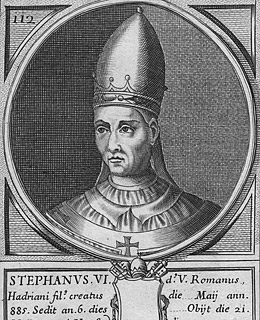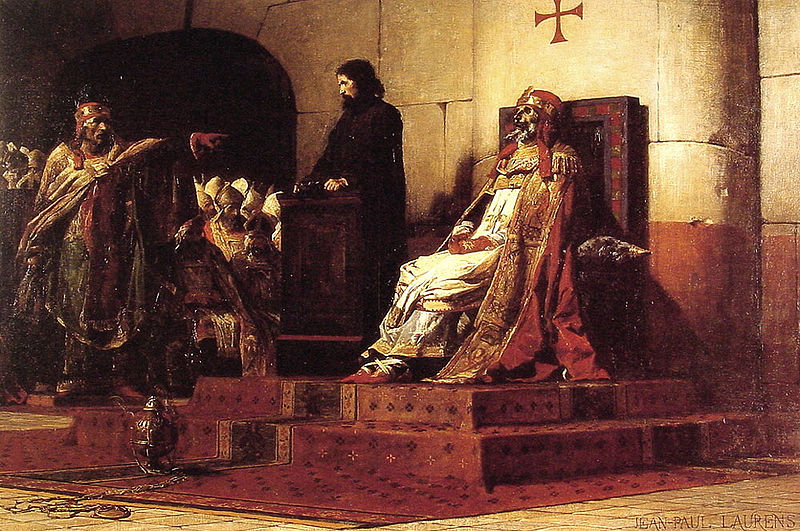<Back to Index>
- Pope Stephen VI, 896-897
- Pope Sergius III, 904-911
PAGE SPONSOR


Pope Stephen VI (died August 897) was Pope from 22 May 896 to August 897.
He had been made bishop of Anagni by Pope Formosus. The circumstances of his election are unclear, but he was sponsored by one of the powerful Roman families, the house of Spoleto, that contested the papacy at the time.
Stephen is chiefly remembered in connection with his conduct towards the remains of Pope Formosus, his last predecessor but one. Doubtless under pressure from the Spoleto contingent and fueled by Stephen's fury with his predecessor, the rotting corpse of Formosus was exhumed and put on trial in the so-called Cadaver Synod (or Synodus Horrenda), in January 897. With the corpse propped up on a throne, a deacon was appointed to answer for the deceased pontiff, who was condemned for performing the functions of a bishop when he had been deposed and for receiving the pontificate while he was the bishop of Porto, among other revived charges that had been leveled against Formosus in the strife during the pontificate of John VIII. The corpse was found guilty, stripped of its sacred vestments, deprived of three fingers of its right hand (the blessing fingers), clad in the garb of a layman, and quickly buried; it was then re-exhumed and thrown in the Tiber. All ordinations performed by Formosus were annulled.
The
trial excited a tumult. Though the instigators of the deed may actually
have been Formosus' enemies of the House of Spoleto (notably Guy IV of Spoleto), who had recovered their authority in Rome at the beginning of 897 by renouncing their broader claims in central Italy, the scandal ended in Stephen's imprisonment and his death by strangling that summer.

Pope Sergius III was a pope of the Roman Catholic Church from 29 January 904 to 14 April 911. Because Sergius III was possibly the only pope known to have ordered the murder of another pope and the only pope to have fathered an illegitimate son who later became pope (John XI), his pontificate has been described as "dismal and disgraceful".
Sergius was the son of Benedictus and came from a noble Roman family. His tenure was part of a period of feudal violence and disorder in central Italy, when the Papacy was a pawn of warring aristocratic factions, often led by prominent women.
The pontificate of Sergius III, according to Liutprand of Cremona, was remarkable for the rise of what papal historians saw as a "pornocracy", or "rule of the harlots", a reversal of the natural order as they saw it, according to Liber pontificalis and a later chronicler who was also biased against Sergius III. This "pornocracy" was an age with women in power: Theodora, whom Liutprand characterized as a "shameless whore... [who] exercised power on the Roman citizenry like a man" and her daughter Marozia, the mother of Pope John XI (931 – 935) and reputed to be the mistress of Sergius III, largely upon a remark by Liutprand.
Sergius III owed his rise to the power of his patron, the military commander Theophylact, Count of Tusculum, who held the position of vestiarius, the official at the top of papal patronage in control of the disbursements, and thus of patronage. Sergius III and his party opposed Pope Formosus (891 – 896), who ordained him bishop of Caere (Cerveteri) in order to remove him from Rome, as an unsympathetic source records. He was his faction's unsuccessful candidate for the papacy in 896. When Pope John IX (898 – 900) was elected instead, he excommunicated Sergius, who had to withdraw from his see at Cerveteri for safety. Sergius was forcibly exiled by Lambert, duke of Spoleto, and all the official records were destroyed; consequently, most of the surviving documentation about Sergius comes from his opponents.
When Antipope Christopher (903 – 904) seized the seat of St. Peter by force, the Theophylact faction of Romans revolted and ejected him in 903 – 904. They then invited Sergius III to come out of retirement. His return is marked as 29 January 904.
At last in power, Sergius III now annulled all the ordinations of Formosus and demanded all bishops ordained by Formosus be reordained, an unwelcome decision reversed again after his death. Sergius honoured Pope Stephen VI (896 – 897), who had been responsible for the "Cadaver Synod" that had condemned and mutilated the corpse of Pope Formosus, and placed a laudatory remark on Stephen VI's tombstone. He then reportedly had the much abused corpse of Formosus exhumed once more, tried, found guilty again, and beheaded, thus in effect conducting a second Cadaver Synod: although Joseph Brusher, S.J. says that "Sergius [III] indulged in no resurrection - man tactics himself" and Schaff, Milman, Gregorovius, von Mosheim, Miley, Mann, Darras, John the Deacon of Naples, Flodoard, and others make no mention of this story.
Pope Leo V (903) and Antipope Christopher, both died in 904, allegedly strangled in prison on the order of Sergius, a claim that the Catholic Encyclopedia called "extremely doubtful."
Sergius III restored the Lateran Palace, which had been shattered by an earthquake in 896. He is the first Pope to be depicted wearing the papal tiara.
The Catholic Encyclopedia states the following concerning the alleged illicit relationship of Pope Sergius III with Marozia: "that he put his two predecessors to death, and by illicit relations with Marozia had a son, who was afterwards John XI, must be regarded as highly doubtful. These assertions are only made by bitter or ill informed adversaries, and are inconsistent with what is said of him by respectable contemporaries."